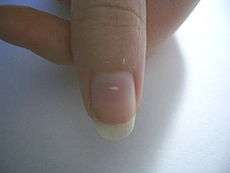Leukonychia
| Leukonychia | |
|---|---|
 Leukonychia | |
| Classification and external resources | |
| Specialty | Dermatology |
| ICD-10 | L60.8, Q84.4 |
| ICD-9-CM | 703.8, 757.5 |
| DiseasesDB | 14140 |
Leukonychia (or leuconychia), also known as white nails or milk spots,[1] is a medical term for white discoloration appearing on nails.[2]:658–9 It is derived from the Greek words leuko ("white") and onux ("nail"). The most common cause is injury to the base of the nail (the matrix) where the nail is formed.
It is harmless and most commonly caused by minor injuries, such as nail biting, that occur while the nail is growing. While commonly held to be due to a calcium deficiency,[3] deficiency of albumin due to liver disease is the primary deficiency causing leukonychia [4]. When caused by injury the marks will disappear as the nail grows outwards, however a dietary deficiency will cause recurrent leukonychia.
Types

Leukonychia totalis
This condition is a whitening of the entire nail. This may be a clinical sign of hypoalbuminaemia (low albumin), which can be seen in nephrotic syndrome (a form of kidney failure), liver failure, protein malabsorption and protein-losing enteropathies. A genetic condition, and a side effect of sulphonamides, a family of antibiotics can also cause this appearances. .
Leukonychia partialis
This condition is whitening of parts of the nail plate in form of small white dots. There are several types of this condition. There are three variations of partial leukonychia; punctate, transverse and longitudinal leukonychia. Some more serious variations of leukonychia partialis may lead to Leukonychia totalis.[5]
Leukonychia striata
Leukonychia striata, transverse leukonychia, or Mees' lines are a whitening or discoloration of the nail in bands or "stria" that run parallel the lunula (nail base). This is commonly caused by physical injury or disruption of the nail matrix. Common examples include excessive tapping of the nails, slamming a car door or extensive use of manicure.[6] It may also occur in great toenails as a result of trauma from footwear. Alternatively, the condition can be caused by heavy metal poisoning most commonly by lead[7] or arsenic.[5] It can also be caused by cirrhosis or chemotherapy.[8] The tendency toward leukonychia striata is sometimes inherited in an autosomal dominant fashion. In other cases, it can be attributed to vigorous manicuring and trauma aforementioned, or to a wide variety of systemic illnesses. Serious infections known for high fevers, measles, malaria, herpes, and leprosy may also cause this condition. In many patients, there is no obvious cause, and the streaks resolve spontaneously.[9] There is a similar condition called Muehrcke's lines (apparent leukonychia) which differs from leukonychia in that the lines fade with digital compression and does not migrate with the growth of the nail.[10]
Leukonychia punctata
Also known as "true" leukonychia, this is the most common form of leukonychia, in which small white spots appear on the nails. Picking and biting of the nails are a prominent cause in young children and nail biters. Besides parakeratosis, air that is trapped between the cells may also cause this appearance.[5] It is also caused by trauma. In most cases, when white spots appear on a single or a couple of fingers or toes, the most common cause is injury to the base (matrix) of the nail. When this is the case, white spots disappear after around eight months, which is the amount of time necessary for nails to regrow completely. The pattern and number of spots may change as the nail grows.[11]
Longitudinal leukonychia
Longitudinal leukonychia is far less common and features smaller 1mm white longitudinal lines visible under the nail plate. It may be associated with Darier’s disease.[5]
Diagnosis and treatment
A doctor will take a thorough medical history, and may take blood tests as well as examining liver and kidney function. Some physicians believe it is a sign of zinc deficiency [12] Intracellular (Red blood cell) assays are more sensitive than tests for plasma levels.
References
- ↑ James, William; Berger, Timothy; Elston, Dirk (2005). Andrews' Diseases of the Skin: Clinical Dermatology. (10th ed.). Saunders. Page 789. ISBN 0-7216-2921-0.
- ↑ Freedberg, et al. (2003). Fitzpatrick's Dermatology in General Medicine. (6th ed.). McGraw-Hill. ISBN 0-07-138076-0.
- ↑ http://www.huffingtonpost.com/2013/09/24/nail-facts-fingernails_n_3957467.html
- ↑ http://www.jtad.org/2009/1/jtad93101r.pdf
- 1 2 3 4 Journal of Turkish Academy of Leukonychia
- ↑ Medscape Today: Traumatic Transverse Leukonychia
- ↑ Baran, Robert et al. Baran and Dawber’s Diseases of the Nails and Their Management. John Wiley & Sons, 2012. Print.
- ↑ Miles DW, Rubens RD (1995). "Images in clinical medicine. Transverse leukonychia". N. Engl. J. Med. 333 (2): 100. doi:10.1056/NEJM199507133330205. PMID 7777013.
- ↑
- ↑ Huang, T.-C.; Chao, T.-Y. (14 December 2009). "Mees lines and Beau lines after chemotherapy". Canadian Medical Association Journal 182 (3): E149–E149. doi:10.1503/cmaj.090501.
- ↑ The Nail Geek: My Big Fat Greek Leukonychia
- ↑ Kelly MP, Kight MA, Castillo S. Adv Ren Replace Ther. 1998 Jul;5(3):241–51. "Trophic implications of altered body composition observed in or near the nails of hemodialysis patients."
External links
| Wikimedia Commons has media related to Leukonychia. |
- What causes white spots on your fingernails? at The Straight Dope
- -234487799 at GPnotebook
- DermAtlas 129
| ||||||||||